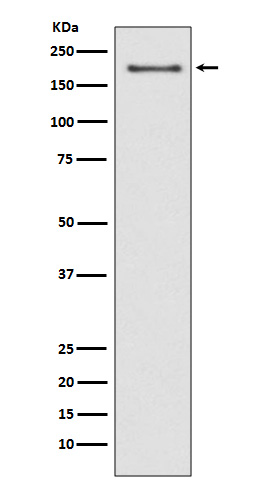
| WB | 1/1000-1/2000 | Human,Mouse,Rat |
| IF | 咨询技术 | Human,Mouse,Rat |
| IHC | 咨询技术 | Human,Mouse,Rat |
| ICC | 技术咨询 | Human,Mouse,Rat |
| FCM | 1/20-1/100 | Human,Mouse,Rat |
| Elisa | 咨询技术 | Human,Mouse,Rat |
| Aliases | Wolf Hirschhorn syndrome candidate 1 like 1; WHSC1L1; NSD3; pp14328; Histone-lysine N-methyltransferase NSD3; Protein whistle;;NSD3 |
| WB Predicted band size | Calculated MW: 162 kDa ; Observed MW: 161 kDa |
| Host/Isotype | Rabbit IgG |
| Antibody Type | Primary antibody |
| Storage | Store at 4°C short term. Aliquot and store at -20°C long term. Avoid freeze/thaw cycles. |
| Species Reactivity | Human,Mouse,Rat |
| Immunogen | A synthesized peptide derived from human NSD3 |
| Formulation | Purified antibody in PBS with 0.05% sodium azide,0.05% BSA and 50% glycerol. |
+ +
以下是关于NSD3抗体的3篇代表性文献,涵盖其应用和功能研究:
---
1. **文献名称**:*NSD3 is a conserved regulator of interferon signaling and antiviral responses*
**作者**:Li Y, et al.
**摘要**:本研究利用NSD3特异性抗体,通过ChIP-seq和免疫沉淀技术,揭示了NSD3在调控干扰素信号通路中的关键作用。实验表明,NSD3通过修饰组蛋白H3K36甲基化,影响抗病毒基因的转录激活。
---
2. **文献名称**:*Targeting NSD3-mediated histone methylation inhibits small cell lung cancer progression*
**作者**:Wang X, et al.
**摘要**:该研究开发了一种高亲和力的NSD3单克隆抗体,用于抑制小细胞肺癌中NSD3的酶活性。通过Western blot和免疫组化验证,证明抗体可特异性识别NSD3并阻断其致癌功能,为靶向治疗提供新策略。
---
3. **文献名称**:*NSD3 cooperates with BRD4 to drive oncogenic transcriptional programs in triple-negative breast cancer*
**作者**:Shen C, et al.
**摘要**:研究通过NSD3抗体进行染色质共沉淀分析,发现NSD3与BRD4在乳腺癌中协同调控促癌基因表达。抗体验证实验表明,NSD3的缺失显著降低肿瘤细胞的增殖和转移能力。
---
这些文献展示了NSD3抗体在基础机制研究、癌症靶向治疗及表观遗传调控中的多样化应用。如需具体实验细节或扩展阅读,可进一步检索相关数据库。
The NSD3 (Nuclear Receptor Binding SET Domain Protein 3) antibody is a critical tool for studying the role of NSD3. a histone methyltransferase involved in epigenetic regulation. NSD3. part of the NSD family, catalyzes the dimethylation of histone H3 at lysine 36 (H3K36me2), influencing chromatin structure and gene expression. It has garnered attention due to its oncogenic potential, particularly through gene amplifications or fusions (e.g., NSD3-NUTM1) observed in cancers like breast cancer, lung squamous cell carcinoma, and leukemia. Dysregulated NSD3 activity is linked to aberrant cell proliferation, differentiation, and therapy resistance, such as in tyrosine kinase inhibitor-resistant cancers.
NSD3 antibodies are widely used in research to detect protein expression, localization, and interactions via techniques like Western blotting, immunohistochemistry, and immunoprecipitation. They help elucidate NSD3's role in disease mechanisms, including its interplay with oncogenic pathways (e.g., MYC) and its potential as a therapeutic target. Commercially available antibodies vary in specificity, targeting distinct epitopes (e.g., N-terminal, catalytic SET domain). Validation using knockout cell lines or siRNA is essential to ensure reliability. Recent studies also explore NSD3 inhibitors, underscoring the antibody's utility in preclinical drug development. Overall, NSD3 antibodies are vital for advancing our understanding of epigenetic dysregulation in cancer and other diseases.
×